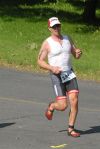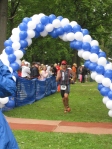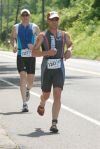
I've been a strong runner for years and more importantly a strong
hill runner. Friends, coworkers and other runners have often asked how I became
so good at running hills and what can they do become better at them. There are
many answers to the second part of the question, but the answer to the first
goes back many years.
I started running competitively in 7th grade. I had wanted to go
out for football when I got to middle school, but due to my size my parents
wouldn't let me. The previous spring I had done really well at our school's
field day in the mile run, so I decided to try cross country instead and fell
in love with running.
The two years I ran in middle I worked hard, did what coach asked,
but no more. All of my team mates avoided hills whenever possible and I
followed suit. Hills sucked! I hated them! They hurt and just weren't fun to
run. Some of the race courses we ran had them, but why run hills repeatedly
when you may only see one hill in a race. So, unless we had to run them in
practice, we didn't run them.
I carried this philosophy with me to high school and quickly
learned that it was shared by my new team mates. We'd run the hills that coach
made us run, but when we were just given a set time to run, we always avoided
them, which, considering I grew up in northern Indiana, was very easy to do.
I began my 9th grade season on the freshmen team but quickly moved
up to the junior varsity (JV) team. At certain big meets where they had a
freshmen team race, I would drop back down so we could try to win it. One of
the races I did this for was the New Prairie Invitational.
A week before the New Prairie Invitational the upper classmen
started talking about Agony Hill. Supposedly there was this monster hill on the
course that humbled seniors and ate freshmen alive. The closer we got to the
meet, the more they talked about it, until we went to sleep dreaming about it.
I didn't take them too seriously, these were the same guys that took us out
snipe hunting at cross country camp almost two months ago, so I took what they
told us with a grain of salt. I was convinced this was just another part of the
initiation.
Race morning we pulled up to the school in our bus. I was glued to
the windows with the rest of the freshmen looking for the monster hill. But no
hill was to be seen anywhere. The area around the school was flat farmland, the
school property was flat and the small woods adjacent to it showed no
indication of hiding a hill in it. The trees weren't tall enough and showed no
increase in height anywhere. We knew we had been suckered.
We got off the bus and did our warm up around the school property.
We found one small "hill" that took all of 2-3 strides to get up and
joked around about it being Agony Hill. We started joking around as all fear
left us. After running we stretched and got ready to race.
We lined up to start the race with 16 other teams, each team
allowed to have 2 people on the actual line and the rest behind. We had about
100 yards before a sharp right turn so it was very important to get out fast.
The gun went off and I took off like a shot. I was one of the first
10 to reach the turn and found myself in great position. The whole first mile
was on flat, hard grass. We did have that one "hill" to run up with
that we joked about, but it didn't slow things any. I don't remember that mile
split, but to give you an idea how fast that course was through the first mile,
as a senior I was in lead group of 8 that went through the mile mark in 4:45.
We weren't that fast, but we were moving quickly.
About 100 yards after the first mile mark we went into the woods
and started to run slightly down hill on the trail to a dried up creek bed. The
next 1/2 mile wound along that creek bed which had a sandy bottom, making
running difficult. The banks were kind of steep so it was hard to run on them
and you were pretty much forced into the sand. However, the sand was not my
main concern. I was starting to get very worried because, even though very
gradual, we were still going downhill. Distance can be deceiving in the woods,
but I was pretty sure that we'd been going downhill for quite a while and I was
starting to think maybe the upper classmen hadn't been joking after all.
Sure enough, we made a turn and there it was, Agony Hill. It
looked more like a dirt wall than a hill. This thing went almost straight up
and it was a solid distance to the top. I hit the thing at full speed and was
instantly slowed to less than walking speed. Some the runners in front of and
behind me were using their hands to help claw their way up and I quickly joined
in.
It seemed like an eternity before I finally reached the top. I
crested Agony Hill and knew I was done. There was still over a mile to go and
my legs were cashed in and gone. I staggered on and just focused on keeping my
feet moving and nothing more. After what seemed like an eternity I crossed the
finish line. I had been beaten. Not just by other runners, but by Agony Hill.
It was my master.
It was a long ride home after the race. I had been humbled and was
embarrassed by my performance. But a new runner emerged during that bus ride.
By the time we pulled into our school's parking lot I had resolved to never,
ever, let a hill do that to me. I didn't know how I was going to beat Agony
Hill, only that I would do it.
From then on, any time I got a chance to run a hill, I would. My
team mates would get upset with me, but I became obsessed with them and any
time I could I would steer runs toward them. This wasn't easy to do either,
there really were very few hills in the area, but I soon knew them all. I would
run them on weekends, and breaks. I would do loop after loop after loop over
them. I still hated running them, they still hurt, but I was determined to
master them.
By the end of the following summer I was looking forward to my
rematch with Agony Hill. Race day couldn't come soon enough. Unfortunately, one
week before the meet my season came to an end with an injury. I would travel to
New Prairie with the team, but instead of facing Agony Hill I would be taking
times and cheering from my crutches. The hill seemed to laugh at me that day,
knowing I would not beat it again that year.
Over the course of the next year I ran hills even harder and went
into my third match up with Agony Hill confident I was going to be the better. I
looked forward to every race, and put my all into each one. But the one I
looked forward to most wasn’t until midseason. When the day of the New Prairie
Invitational finally arrived I was ready. As I had two years previous, I again charged
onto Agony Hill and again it showed its might. But, this time when I crested it
I still had something left in my legs and was actually able to run on. I still
slowed tremendously, but I was definitely running strong. The win that year was
mine, but it was like Rocky beating Apollo, it was only because I got back on
my feet first. I still had work to do.
After another year of hard work my senior year came and the final
match up with Agony Hill with it. I already mentioned how the first mile went.
I finished the 5k course in about 16:23, a PR, and more importantly, when I
crested Agony Hill I took off and hammered the last part of the race. I crushed
it. Agony Hill was mine.
Beating Agony Hill was great, but the real victory occurred
somewhere along the way to get to that point. I don't know when it happened,
but it did, and that's all that matters. Somewhere I lost my fear of hills, I
didn't dread them anymore. I enjoyed running them and they became my friends.
They still hurt, but it was a good hurt that I welcomed. Running hills will
never be easy, it is just like running the 100 meter dash all out. If you are
really, truly pushing as hard as you can, it will hurt, it's just the better
trained you are the less it hurts and the quicker the hurt fades away. Same
with running a marathon. I will never say running hills is easy, but if easy
was what I wanted I wouldn't be an athlete to begin with.
This same philosophy and love of hills that I got from running has
carried over to cycling as well. I go at hills on my bike the same way I do
when running. I challenge every hill I see and grind it out in the biggest
gears I can. Both when riding and running, if I come to an intersection and I'm
unsure which way to go, I always take the one that looks like it goes up the
most.
When I asked my recommendations for getting better at running
hills it is simple, run them. Run them often, run them hard, don't fear them,
embrace and respect them, but strong. Since my freshman year at the New Prairie
Invitational I have run every hill possible, there hasn't been a single hill
not taken, and that has made all the difference.




































